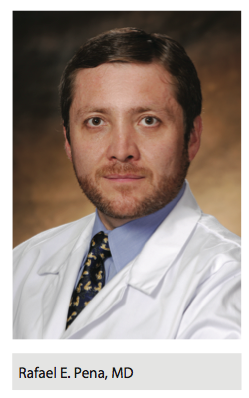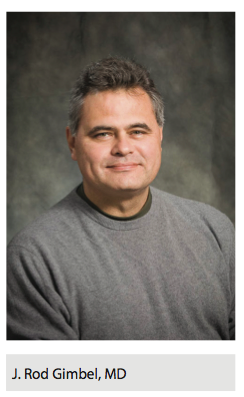ADVERTISEMENT
Update on the ProMRI Study: The Role of MRI-Compatible ICDs in Improving Patient Care
In this interview we speak with cardiac electrophysiologists Rafael E. Pena, MD, FACC from The Arrhythmia Institute in Newtown, Pennsylvania, and J. Rod Gimbel, MD, FACC in Knoxville, Tennessee, about MRI access, as well as about details on the first patient with an ICD who underwent an MRI scan as part of the FDA-approved investigational ProMRI study.
underwent an MRI scan as part of the FDA-approved investigational ProMRI study.
What are some of the reasons why a patient might need an MRI scan? What are some of the risks to an ICD patient during an MRI scan?
Pena: Many patients will need an MRI scan in their lifetime. If a patient comes to the hospital and a stroke or brain issue is suspected, an MRI is necessary.
Pena: In addition, for any patient dealing with back pain, hip pain, or knee pain — common ailments as patients age — an MRI is the best way to gather information to determine diagnosis and treatment. CAT scans and ultrasounds are generally not good enough. Regarding risk, safety concerns have historically focused on how the focused energy of the magnetism that occurs during MRI creates heat, which impacts the functionality of the device. Leads in the device can become very hot, causing malfunction.
Gimbel: While the majority of MRI scans are done outside the thorax (head/neck, lumbar spine, extremities), the increasing importance of cardiac MRI should be appreciated by all implanters. It’s important to recognize that cardiac MRI will be increasingly used in the future to stage and guide EP procedures (e.g., LV lead placement for CRT, tissue characterization to assess ablation candidacy, mapping, and efficacy of endpoints during atrial fibrillation and VT ablation). The very same patients that have pacemakers and defibrillators will benefit from cardiac MRI. 
Tell us about the first investigational full-body MRI scan in a device patient at St. Mary Medical Center in Langhorne, Pennsylvania. How long did the MRI scan take during this case?
Pena: The patient was experiencing knee pain, and therefore, the orthopedic physician recommended an MRI to properly determine the issue and next step. By utilizing an MRI during the diagnostic process, the orthopedic physician could make an informed decision. Although I am unsure of the specifics for this case since the orthopedic physician ordered the scan, most scans take between 20-40 minutes, depending on the protocol. Prior to the MRI, the ICD undergoes a comprehensive interrogation, pacing threshold, and sensing evaluation to ensure that everything is working normally. These all were completed and verified as normal. Prior to having the MRI, the ICD is reprogrammed into the MRI mode which turns off VT/VF detection and therapy to eliminate the possibility that the device can sense the MRI noise as an arrhythmia. Additionally, the MRI mode allows the physician to either pace the patient asynchronously or to deactivate pacing in the case that the patient has a good underlying rhythm. The patient underwent the MRI scan without any issues. Immediately following the MRI, VT/VF detection and therapy was reactivated and another comprehensive ICD follow-up was completed. The patient did not exhibit any pacing threshold or R-wave changes from the MRI, in fact, the ventricular pacing threshold decreased slightly by 0.2 V.
What are some of the risks to an ICD patient during an MRI scan?
Gimbel: “Off-label” scanning of ICD patients is particularly troubling. The problem of “power-on-reset” during MRI remains a serious issue, as the patient’s device can “reset” to an “ICD on” status without warning. When this happens during an MRI, a repetitive charge and dump sequence can take place, depleting the battery during the MRI. At the end of the MRI, the patient’s device is interrogated and found to be drained, needing a replacement and making for an expensive MRI indeed. This risk can all be avoided by implanting an MRI-conditional ICD that has special circuitry, filters, and modifications designed to prevent “power-on-reset” during MRI.
Why is this technology so critical for patients?
Pena: MRI scans provide knowledge that helps physicians make informed decisions. All patients should have access to this technology. Most patients will need an MRI scan in their lifetime. This investigational study is critical and will change the quality of care for patients. Patients that suffer from stroke, brain tumors, knee pain, hip issues, and many other ailments have been unable to safely undergo MRI scans, creating situations in which physicians often have to make decisions about treatment without maximum knowledge. The first MRI scan of a patient implanted with the BIOTRONIK Iforia ICD is an important step towards evolving care for patients with ICDs.
What patient population will benefit most from this technology?
Gimbel: Every patient who needs an implantable device of any kind should have continued access to MRI. The usual age of a (rhythm) device patient is approximately 65-75 years old. In this age group, orthopedic, neurologic, and oncologic disease are increasingly present. Ask any orthopedist, neurologist, or oncologist what their go-to imaging tool is, and they’ll tell you “MRI”. Because of MRI’s importance, every patient who needs an implantable device should have an MRI conditionally compatible device so that they have preserved access to MRI.
Is there anything else you’d like to add?
Gimbel: In some ways, this is an issue of economic fairness. We should remember that “health care debt” is the leading cause of personal bankrupty in the United States. As was pointed out in a recent editorial in the New England Journal of Medicine, “many patients in the United States experience substantial harm from medical interventions whose risks have not been fully discussed. The undisclosed toxicity? High cost, which can cause considerable financial strain.”1
Understanding how this applies to “device choice” (MRI conditional vs. not MRI conditional) for the implanting clinician is a case of helping the physician understand the “total economic footprint” of their choice for the patient. When a device is implanted that is not MRI conditional, it may exclude the patient from having an MRI, potentially delaying diagnosis and treatment, obligating the clinician to utilize suboptimal imaging and treatment strategies and thereby increase the cost of care. The burden of this increased cost of care and delay in diagnosis is borne not only by the medical system as a whole but often by the patient who is expected to bear an increasingly large fraction of the cost of their health care.
Even if the patient finds a hospital system willing to perform an “off-label” MRI expeditiously, that patient may be expected to pay “out-of-pocket” for the cost of the MRI, as CMS will not pay for an MRI on a patient with a non-MRI conditional device. The exorbitant cost of health care is thus made worse, and particularly egregiously personal to the patient, who is not only sick but can often ill-afford an expensive MRI. It should be noted that CMS will pay for an MRI if the device is MRI conditionally compatible.
often ill-afford an expensive MRI. It should be noted that CMS will pay for an MRI if the device is MRI conditionally compatible.
We are not the stewards of our patient’s finances, nor should we seek to be such stewards. We should, nevertheless, be cognizant of the economic realities of our choices that we make when we implant a pacemaker or ICD. The total economic footprint of our device choices should be appreciated. Placing a pacemaker or ICD in a patient that is not MRI conditionally compatible may place an unfair and undue economic burden on the patient. This undue and unfair economic burden, a spiral of illness and debt imposed on patients who often can least afford it, can in part be lessened by placing an MRI conditionally compatible device.
Disclosures: The authors have no conflicts of interest to report regarding the content herein. Outside the submitted work, Dr. Gimbel reports personal fees from Medtronic and BIOTRONIK.
Reference
- Ubel PA, Abernethy AP, Zafar SY. Full Disclosure — Out-of-Pocket Costs as Side Effects. N Engl J Med. 2013;369:1484-1486.
|
About the BIOTRONIK Iforia ICD and DX device systems with ProMRI® technology: Iforia is BIOTRONIK’s latest ICD technology platform and is the first ICD in the industry to begin FDA-approved clinical review for MRI conditional labeling in the U.S.The Iforia system consists of the ICD together with BIOTRONIK’s existing defibrillator (Linoxsmart) and pacemaker (Setrox) leads. Iforia offers longevity and daily monitoring through BIOTRONIK Home Monitoring®. The BIOTRONIK DX ICD system provides physicians with the complete diagnostic capabilities of a dual-chamber ICD, including atrial sensing and advanced proven shock reduction algorithms, with only a single lead. BIOTRONIK introduced DX technology in 2013 in the U.S., and it has been quickly adopted by electrophysiologists nationwide. Patients prefer implants with less hardware, while physicians benefit from dual-chamber diagnostic data.
About Phase C of the BIOTRONIK ProMRI® study:The new phase of the trial (Phase C) is evaluating BIOTRONIK’s ProMRI® technology in ICD devices, with an approved expansion for subjects to receive full-body scans, and for the first time, includes patients with DX implantable ICDs in the study. The first phase of the ProMRI® trial (Phase A) evaluated the safety of the BIOTRONIK Entovis pacemaker systems during MRI scans, excluding scans in the chest area. This phase was completed on November 18, 2013. On May 7, BIOTRONIK announced the FDA-granted approval of the Entovis pacemaker system with ProMRI® technology, allowing patients to undergo MRI scans with a limited exclusion zone.
This trial represents Phase C of the study and is in the early phase. The first four sites are St. Mary Medical Center in Langhorne, PA; New York University Langone Medical Center in New York, NY; University of Alabama at Birmingham in Birmingham, AL; and the University of Michigan Medical School in Ann Arbor, MI. Currently, six patients are enrolled at three sites. The study intends to enroll 172 patients at 40 sites, which BIOTRONIK anticipates will occur throughout the next year. |











